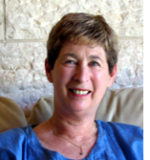By Dorothea Shefer-Vanson

MEVASSERET ZION, Israel — Elena Ferrante’s novels about her childhood in a run-down Naples neighbourhood and her life subsequently focus to a great extent on her friendship with Lina, a.k.a. Lila, the girl who dominated her life as a child and to some extent as an adult, too. The character of Lina is portrayed as a mixture of angel and demon, someone of great intelligence but also with a destructive and vengeful nature. The relationship between the two girls is one of love-hate and mutual fascination.
This led me to give some thought to my own experience of friendship, both as a child and as an adult. In childhood one’s friends play an important role as regards to both one’s self-image and one’s sense of confidence. Until I was about ten years old my family lived in an impoverished part of London (which has since been gentrified) and my next-door neighbor was a girl of my own age, Jeannie.
What was unusual for those days, soon after WWII, was the fact that she came from a large family and was the third of six siblings. We both spoke English, but she spoke as the local Cockneys did, whereas I spoke what I assume was the English I learned at school and from my parents (and the radio). Her family was Christian and mine was Jewish, and although my parents were refugees from Germany we two little girls were happy to skip rope and play ball together in the street outside our house or in our garden.
Jeannie was smart and knew about all kinds of things that were alien to me, but despite the cultural gulf between us we understood one another and enjoyed one another’s company. My world became darker when her family was finally awarded a council house in another part of London and moved away. We visited one another desultorily after that, but the distance made such visits few and far between, and eventually they stopped. It never occurred to us to write to one another, and so over the years we have lost contact.
When I went to grammar school at the age of eleven I found a new friend, Diana, and we were very close throughout the six years of our school career. We came from similar backgrounds, lived just two stops away from one another on the tube (on what was then the Bakerloo line and is now the Jubilee line), and would go to our respective homes together, and then spend hours on the phone to one another. We went to different universities, and when Diana got married at a very young age (almost like Lila in Ferrante’s book) our lives diverged radically. We both moved to Israel later, but to different parts of the country and in different circumstances.
When the Six-Day War broke out in June 1967 Diana was in England visiting her family, and decided to remain there. Our lives diverged but we remained in contact through snail mail. It was always a red-letter day for me when an envelope in Diana’s unmistakable handwriting arrived in our letterbox. But life took over, gradually the letters became fewer and eventually stopped. Today we don’t even communicate by email. But when either of us visited the country where the other one was living we would see each other, although the closeness of earlier times was never recaptured. We still remain very fond of one another, however (at least I am of her).
The friends we acquire in adult life tend to assume a less prominent role in one’s consciousness, and although I feel I do have some very good and close women friends with whom I can share the things that concern me, the intimacy of one’s childhood and youth cannot be recaptured. Maybe that’s just an indication that I’m finally growing up, but without those friends I know my life would be impoverished.
*
Shefer-Vanson is an author and freelance writer based in the Jerusalem suburb of Mevasseret Zion, Israel. She may be contacted via dorothea.shefer@sdjewishworld.com